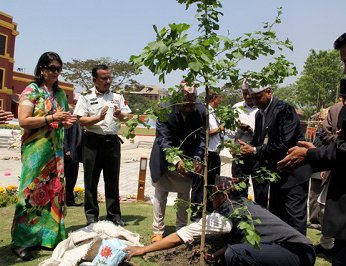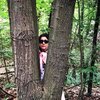
As I was taking a round of Sheetal Niwas with President Dr. Ram Baran Yadav, planting the world's unique fossil tree on earth, the ''GINKGO BILOBA, '' I was overwhelmed with joy that my dream to make ''Sheetal Niwas: A GINKGO Palace'' could come true. Yes, as part of the dream, I was planting these wonderful trees alongside the President.
No doubt this would make the place one of the unique historical palaces, the first President's House with a mass of Ginkgoes, around 169 trees, most being grown with saplings planted with the theme of "GREENING THE EARTH."
I found President Dr. Yadav was keen on conservation as were all other staff at the President's House. They were all part of the initiative in choosing one of the unique species, which I had proposed. All the cost was borne by the President's Office.
Planting Ginkgoes in Nepal, a mass plantation, goes back to 2004, when we, Save The Environment Foundation (SEF), along with Love Green Nepal, planted around 300 Ginkgoes inside Tundikhel and Nepal Army pavilion. The little saplings which we planted are now almost fully grown up, adding more beauty to the surrounding. We (SEF) constantly looked after these trees as they grew up. SEF has till now planted more than 4000 Ginkgoes all over the country, mostly at Army HQ , Kharipati Barrack, various golf courses and other places.
Ginkgo Biloba trees originally come from China. In fact, these trees are the national trees of China. Ancient Ginkgo trees were discovered in Tiantan village of Chengshan county. The first reliable source suggests the trees came to be known at the time of Sung Dynasty. The oldest Ginkgo ovulate organs is dated back to about 170m years in the middle of the Jurassic period. A 4000-year old Ginkgo in China is called the '' Chinese Ginkgo King '' .
An older Chinese name for Ginkgo is ''silver fruit '', the apricot like fruit produced by female trees which can be used as snacks, if taken moderately and served at special occasions such as weddings and the Chinese New Year, a dish called '' Buddha's delight '' . These trees are regarded as sacred trees for making wishes, worship and prayers .
Ginkgo trees arrived in Japan with Zen Budhism in the Kamakarma Period. These trees are called 'Bearer of Hope' as they survived the Hiroshima bombings. Six Ginkgo trees survived near the blast center and are still alive. They are preserved by rebuilding temples around it engraved with sings of “No more Hiroshima Bombings.'' Hence these Ginkgoes are regarded as official trees of Tokyo and symbol of the Ginkgo tree is a Ginkgo leaf .
Ginkgo trees have been wildly planted around temples and trees alongside avenues in Japan for their magnificent “Autumn Gold'' which make trees Golden throughout the Autumn. The Ginkgo Fall is worth watching. Ginkgo trees are prized for their Autumn foliage which is deep saffron yellow.
Ginkgo leaves are unique, fan shaped leaves, hence its popular name is ''Maiden Tree''. The famous poet Goethe has written a brilliant poem on Ginkgo leaves in 1815, a hand written poem pasted with two Ginkgo leaves by Goethe is still preserved.
Ginkgo trees have been revered for their beauty and longevity. The only remaining fossil on Earth unchanged for more than 200 million years [ trees from the Jurassic Period], which absorb high amount of CO2 and have been prized for their reputed medicinal properties, is Ginko's .
Extracts from Ginkgo leaves have been used as a memory and concentration enhancer and used mostly for dementia -- it is called a brain tonic as it helps blood flow. The market for Ginkgo leaves are higher for its medicinal values.
Ginkgo adapts well to the Urban Environment, tolerating pollution and are excellent urban shade trees which look very ornamental when they turn ''awesome golden'' in Autumn. Hence, Ginkgo trees have been promoted world wide as Avenue trees these days .
While dating back in history for Ginkgo Biloba in Nepal, I have faint remembrance of people talking about the Oldest Ginkgo trees being trans-located to Godavari, though the name of the trees was not mentioned at that time. However, people used to make remarks saying that the unique trees from China were being translocated and chances of their survival were slim.
Just a few months back, I came to know through an article by Sauravji in the Koselee issue of Kantipur that the first Ginkgo Biloba trees were brought and planted in Kathmandu by the Late Col. Harkha Jung Thapa, the first grandson of Jung B . Rana, from the Globe Nursery of Calcutta and stored at Dev nursery of Babar Mahal set up by Maharaja Dev. Sumsher Rana.
What a bond ? I was thrilled knowing about the history of these trans-located trees and here I was obsessed with Ginkgoes. It added more value to me because Col. Harkha Jung Thapa, my Great Grandfather, introduced these Ginkgo trees in Nepal.
I do respect Maharaja Dev Sumsher Rana for his outstanding vision and contribution towards the country and society though he ruled as PM for a very short period and his Dev Nursery played a major role for Greening the Earth by importing rare trees from abroad.
It meant more to me like my great-grandfather Col. Harkha Jung Thapa, Dev Nursery and my passion for Gingko Trees. Most of my SEF ladies are his Granddaughters too and they must have felt the same as I did. He who plants trees plants hope.

Chanda Rana
RANA is an environmental and heritage activist. Currently, She has been launching a campaign to save 2.4 million trees in Nijgardh and several other heritage save campaigns. .
- Churia Tunnel Is First Tunnel Of Nepal
- Nov 12, 2019
- 'We Need Second International Airport But Not At The Cost of 24 Lack Trees '
- Feb 11, 2019
- EIA of GEOCE to Neejgadh International Airport Construction Is Totally Unacceptable"
- Dec 26, 2018
- An Appeal To The Rt. Honorable President Bidhya Devi Bhandari
- Dec 01, 2018
- Presence Of My Father At Neejgadh Jungle
- Oct 31, 2018















